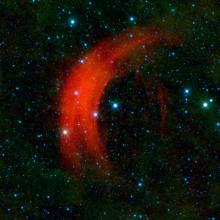Listen to today's episode of StarDate on the web the same day it airs in high-quality streaming audio without any extra ads or announcements. Choose a $8 one-month pass, or listen every day for a year for just $30.
You are here
NGC 1502
For the casual skywatcher, Camelopardalis, the giraffe, is a dud. Only a few of its stars are visible to the unaided eye, and you need dark skies to see even those.
With binoculars, though, you can pick out several pretty sights within the giraffe’s borders. One example is Kemble’s Cascade — a string of about 20 stars along the giraffe’s neck. The stars aren’t related to each other — they just happen to line up in the same direction in the sky.
Near one end of the cascade, though, is a group of several dozen stars that are related: the star cluster NGC 1502. It stands high above the North Star in mid evening.
The cluster is a few thousand light-years away, although the exact distance is uncertain. The cluster’s age is uncertain, too, although it’s probably only a few million years.
One clue to the age is the types of stars the cluster contains. Many of the stars of NGC 1502 are much bigger, brighter, and hotter than the Sun. Such stars live no more than a few tens of millions of years, compared to billions of years for stars like the Sun. Since quite a few of these stars are still around, it means that the cluster can’t be very old.
The brightest member of the cluster is called SZ Cam. It’s a family of six stars, split into three tight pairs. Two of the pairs huddle close together, while the third is much farther out. SZ Cam helps make the cluster worth looking for, in a constellation that’s a little short of skywatching wonders.
Script by Damond Benningfield





